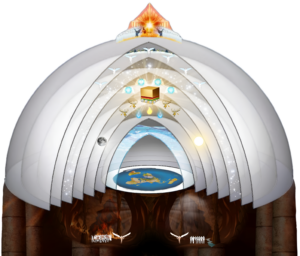Selenelion Eclipse – an uncommon type of lunar eclipse when both the Sun and the eclipsed Moon can be seen at the same time.
A remarkable instance of this kind was observed at Paris, on the 19th of July, 1750, when the moon appeared visibly eclipsed, while the sun was distinctly to be seen above the horizon.”
– Astronomy and Astronomical Instruments,” p. 105. By George G. Carey.
“On the 20th of April, 1837, the moon appeared to rise eclipsed before the sun had set. The same phenomenon was observed on the 20th of September, 1717.”
– McCulloch’s Geography, p. 85.
“In the lunar eclipses of July 17th, 1590; November 3rd, 1648; June 16th, 1666; and May 26th, 1668; the moon rose eclipsed whilst the sun was still apparently above the horizon. Those horizontal eclipses were noticed as early as the time of Pliny.”
– “Illustrated London Almanack for 1864,”
On the 17th of January, 1870, a similar phenomenon occurred; .and again in July of the same year.
– “Daily Telegraph,” July 16th, 1870.
2001, Paul Davies, Duncan Steel, Eclipse: The Celestial Phenomenon That Changed the Course of History (Joseph Henry Press) p. 57
This phenomenon is called a “horizontal eclipse” or, from a French term, “selenelion.” … In modern times, the first record seems to date from 1590, when the great astronomer Tycho Brahe saw a selenelion from his observatory ….
2007, William Poole, “Antoine-Fran็ois Payen, the 1666 Selenelion, and a Rediscovered Letter to Robert Hooke”, Notes and Records of the Royal Society of London, Vol. 61, No. 3 (Sep. 22, 2007), pp. 251-263
This he immediately published, under the title Selenelion ou Apparition Luni-Solaire …. The coinage selenelion was his own …. Payen asserted that refraction on its own could not account for a selenelion…
2010, Kelly Beatty, “In Search of Selenelion”, Sky & Telescope (June 26, 2010) [1]
I decided to watch for an uncommon eclipse phenomenon known as selenelion, seeing the Sun near the horizon and the eclipsed Moon near the opposite horizon at the same time.
2014, Joe Rao, “Total Lunar Eclipse On Wednesday Will Be a Rare ‘Selenelion'” [2]
On Oct. 8, Interested skywatchers should attempt to see the total eclipse of the moon and the rising sun simultaneously. The little-used name for this effect is called a “selenelion,” a phenomenon that celestial geometry says cannot happen.
2014, Alan MacRobert, “Eclipse of a Large Moon”, Sky & Telescope (October 2014) p. 52
Meteorologist Joe Rao points out that this eclipse presents an unusual chance to try seeing a selenelion: when the Sun and eclipsed Moon are both above the horizon at once.


